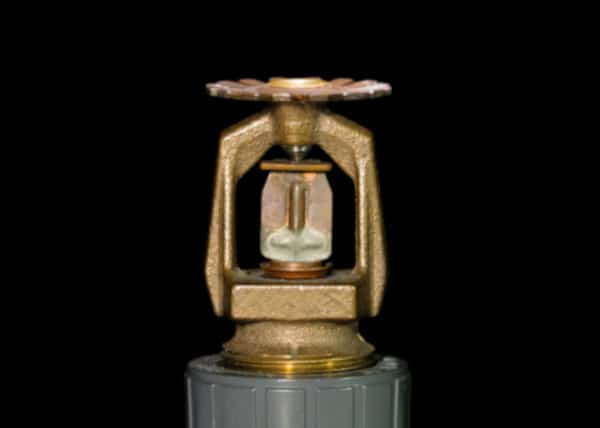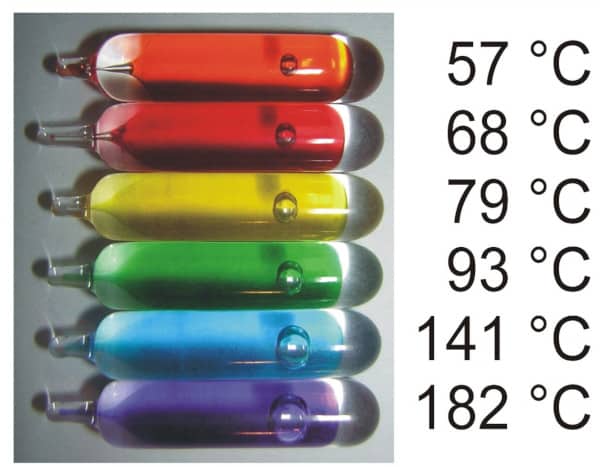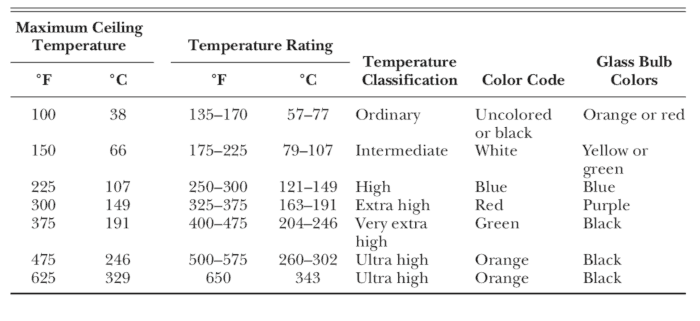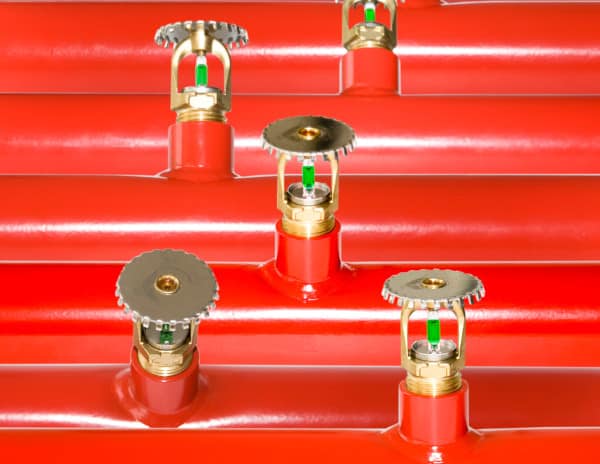A tiny glass bulb or fusible metal link protects most buildings from fire
Many people assume that fire sprinklers are set off by smoke or alarms, but intense heat is really the trigger in most systems. Every sprinkler head is activated separately by a specific temperature in its area — minimizing the potential for costly water damage throughout a building because only the sprinklers needed to put out a fire discharge water.
In fact, the National Fire Sprinkler Association (NFSA) reports that only one or two sprinkler heads activate in 90 percent of structure fires before the flames are extinguished or contained.
In this blog, QRFS takes a look at the different types of heat-sensitive elements in the vast majority of fire sprinkler heads and details exactly how they work.
Are you just looking to buy fire sprinkler heads for your system? View our in-stock selection of commercial head sprinkler pendent, upright sprinkler heads, sidewall sprinkler heads, and concealed fire sprinklers, or our selection of residential fire sprinklers. Otherwise, read on:
How fire sprinklers are triggered
Most fire sprinklers are kept closed by either a fusible metal link or a small glass bulb that contains a heat-sensitive liquid. In a typical sprinkler head, a pip cap (also known as a “plug”) is held in place by one of these two trigger mechanisms.
Glass bulbs filled with a glycerin-based liquid are the most common type of trigger. Here’s how they work:
When a blaze ignites, the air directly above the fire heats rapidly. The hot air is pushed toward the ceiling, walls, or other spots where the sprinkler heads are located. When the air around them reaches a certain temperature – typically 135° F, 155° F, or 250° F (57° C, 68° C, or 121° C) – the liquid inside the bulb expands until the pressure causes the glass to break. In a wet sprinkler system, pressurized water in the sprinkler pipes then forces out the plug and sprays over a deflector plate that disperses it in a uniform pattern throughout the space. The water continues to flow until the main valve is shut or the water supply runs out.
The below animation demonstrates a glass-bulb sprinkler deployment:
In a dry sprinkler system, however, the activated sprinkler head causes the air pressure in the pipes to drop, opening a dry pipe valve near the system riser that holds back the water. The water floods the pipes and disperses through the open sprinklers, a process that can take up to 60 seconds. In contrast, preaction systems typically go off when a sprinkler’s heat-sensitive element is activated and a separate alarm is triggered.
Glass bulbs are most commonly found in two sizes: a 3mm diameter is used in quick-response fire sprinklers and a 5mm diameter is used for standard-response fire sprinklers. In an average-sized room, a 5mm bulb will usually break within 60 to 90 seconds after it comes in contact with a heat source.
The thinner bulbs in quick-response sprinklers break faster, but that doesn’t necessarily make them the best choice for a building. There are many factors to consider before choosing which type of sprinkler fits a given situation, including ceiling height, ambient room temperature, occupancy type, National Fire Protection Association (NFPA) guidance, and more.
As a general rule, sprinkler systems that prioritize saving lives — a priority that applies to most systems in light-hazard commercial and residential applications — use quick-response sprinklers. Standard response sprinklers are employed where protecting property and containing a fire are major considerations.
Fusible link fire sprinklers mirror the concept of glass bulb sprinklers. But in their case, the glass and liquid are replaced by two metal plates held together by solder with a predetermined melting point.
When the area around the sprinkler head gets hot enough, the solder melts, and the two spring arms pull the plates apart. The pip cap, or plug, falls away and the water or pressurized gas (followed by water) it was holding back flows through the sprinkler head.

An exception to these two triggers is found in a deluge sprinkler system, most commonly used to protect highly flammable or hazardous areas where fire can quickly burn out of control. These settings include flammable liquid handling/storage areas, petroleum/chemical plants, and aircraft hangars.
The heat-sensing operating element is missing in deluge systems; all sprinklers connected to the piping remain permanently open. This ensures that water can discharge from all of them at once as soon as an initiating device like a smoke and heat detector activates the system.
Temperature ratings prevent accidental discharges
Automatic sprinklers have different temperature ratings at which their fusible link or glass bulb element is expected to break, enabling water to flow onto a fire. The temperature rating closely tracks rising ceiling temperatures, with options ranging from 135° F all the way up to 650° F (57° C to 343° C).
Because various residential, commercial, and industrial environments (and spaces within them) operate at different normal ambient temperatures, some fire sprinkler heads must be able to resist higher temperatures before activating. It’s essential to match the temperature rating of the sprinkler to the ordinary and maximum expected ceiling temperatures to avoid accidental discharges.
For instance, a fusible link rated between 135° F and 170° F has a maximum ambient temperature rating of 100° F. So if it is routinely exposed to ambient temperatures higher than 100° F, it is liable to separate and trigger water flow.
How to determine the temperature rating of fire sprinklers
In most cases, a sprinkler’s temperature rating is stamped on the fusible link or stamped or cast on a visible part of a glass bulb sprinkler’s head. NFPA 13: Standard for the Installation of Sprinkler Systems also calls for automatic sprinklers to use color codes to indicate temperature rating. For glass bulbs, the color of the liquid inside them shows the temperature rating. For fusible link sprinklers, the color code is generally indicated on the frame arms.
From the 2022 Edition of NFPA 13
7.2.4.1 Automatic sprinklers shall have their frame arms, deflector, coating material, or liquid bulb colored in accordance with the requirements of Table 7.2.4.1(a) and Table 7.2.4.1(b) or the requirements of 7.2.4.2, 7.2.4.3, 7.2.4.4, or 7.2.4.5.
7.2.4.2 A dot on the top of the deflector, the color of the coating material, or colored frame arms shall be permitted for color identification of corrosion-resistant sprinklers.
7.2.4.3 Color identification shall not be required for ornamental sprinklers such as factory-plated or factory-painted sprinklers or for recessed, flush, or concealed sprinklers.
7.2.4.4 The frame arms of bulb-type sprinklers shall not be required to be color coded.
7.2.4.5 The liquid in bulb-type sprinklers shall be color coded in accordance with Table 7.2.4.1 (a).

The below table itemizes the appropriate color coding for a fusible link (“color code” column) and a glass bulb fire sprinkler:

An important safety reminder for fire sprinkler triggers
Since fire sprinklers are activated by heat, smoke, or dust in the air can’t accidentally set them off. But dust, dirt, or other materials like paint can insulate a fusible link or glass bulb from detecting heat and compromise its performance.
Never, under any circumstances, paint a fire sprinkler.
It’s also essential to routinely inspect sprinkler heads for corrosion and debris. If a sprinkler is heavily “loaded” — an industry term for being covered in dust or other material — it must be replaced. If the head is only covered with a light to moderate amount of dust, NFPA states that you can clean the sprinkler head — if you can do it without touching it. To learn how to properly clean a fire sprinkler head, read this.
Also, remember that glass bulbs are fragile; any impact — such as hanging items on sprinkler heads or a repairman accidentally knocking the head — can lead to water flow and very costly damage. Fortunately, there is a fast way to stop an accidentally activated sprinkler head with the right tool.
Automatic sprinkler systems are the first and most effective line of fire defense in any building that has them, reducing the death rate from fires by 87% and containing a blaze to the room where it started 97% of the time. And, contrary to what Hollywood movies portray, fire sprinkler systems don’t deploy all at once.
Simple but effective thermal operating elements hold sprinklers closed until they are triggered by heat — one sprinkler head at a time. This simple, reliable technology means that only the sprinklers necessary to put out a fire are activated, saving the rest of your property from unnecessary damage caused by fire, smoke, heat, or water.
If you’re looking to buyfire sprinklers and fire protection equipment, view QRFS’s selection of fire protection products for residential and commercial buildings.
If you have any questions about the use of glass bulbs or fusible links in fire protection systems or need help finding an item for your system, give us a call at 888.361.6662 or email support@qrfs.com.




Hi there–a guest in our beach house broke the glass bulb on a sprinkler head in the laundry room. I wanted to know how to replace/fix accordingly. Any quote or recommendation on how to do so would be greatly appreciated. Thank you.
-Fritzie Duque
408.318.7568
Fritzie, thanks for reaching out. While QRFS has many options to buy fire sprinkler heads, to replace a fire sprinkler head you need to contact a professional sprinkler contractor in your area. A professional will ensure that your sprinkler head is properly replaced and that your entire sprinkler system is functioning. When it comes to fire protection, safety always comes first!
Can fire sprinklers cause an upper apartment to heat up when the weather is hot? My floor stays very warm almost hot can the water in the sprinklers heat up
Donald — No, the presence of fire sprinklers should not cause an increase in the ambient temperature.
Is there a sprinkler head that could be used in outside applications in a place where the temperature varies greatly month to month?
Thanks!
John Earnest
Provo Fire Department
John — We aren’t aware of sprinklers with variable temperature ratings, and such an application also depends on what types of temperature extremes you are referring to (such as being temperate to extremely hot (Mojave desert) and being worried about activation, or getting very cold and worrying about water freezing). Nevertheless, a sprinkler activation temperature and the water and pipe that supply it must consistently account for ambient temperatures. You can try our Ask a Fire Pro service for a more relevant/detailed answer pertinent to your situation. Click the link to submit your question with some information about your building or system, and a fire protection professional will provide a detailed answer based on standards and codes. Our pros include AHJs, contractors, engineers, and code experts with 150+ years of combined experience!
Can the bulbs stay in a higher heat consistently as long as the heat is below the breaking temp? Or will continuously being in the heat eventually raise the temp of the liquid?
Ryan — Fire sprinklers are designed to go off at specific temperatures ranges. That said, sprinklers have both temperature (activation) ranges and maximum (ambient) ceiling temperatures. For example, an ordinary temperature sprinkler has a temperature rating of 135-170 degrees F, but also a maximum ceiling temperature of 100 degrees F. This is for the essential question you are asking—to avoid accidental activation.
So, in settings where sprinklers will be regularly exposed to ambient ceiling temperatures near or above the max (or specific heat sources, like near an industrial furnace), designers simply specify using a sprinkler with a higher range and maximum ceiling temperature. If a sprinkler is near a skylight in the desert or a dedicated heat source, for example, a system designer might bump up the ordinary classification to intermediate, which has a temperature rating of 175-225 degrees F and a maximum ceiling temperature of 150 degrees F. Hope that helps!
very great work for sprinklers u deserve more likes
Why different color coded temperature rating of sprinklers bulbs are different, due to its glass thickness or inner liquid quantity or other reasons, kindly describe
Faisal — the different colors of sprinkler bulbs are from dye placed in the fluid to identify their temperature rating; the temperature rating is determined by the chemical composition of the fluid; and the thermal sensitivity — how quickly the sprinkler will go off at that temperature — is determined by the size of the glass bulb (bigger 5mm bulbs hold more liquid than 3mm bulbs, thus have a less-sensitive/slower response). Hope that helps!
It is the size of the air bubble in the bulb that impacts the temperature sensitivity.
HI,
I want to know what is the life of Glass bulb of Sprinklers. In what time sprinklers needs to be changes if not in use. Incase they are not in use from long time
Urvashi — The short answer is decades; for a more detailed answer based on sprinkler type and when they need to be tested or replaced, you can read this blog. Thanks!
How far away from normal incandescent lights, inside of a globe, should the sprinkler heads be to insure the heat of the lamp doesn’t set it off?
Joe — It depends on the wattage of the light and the temperature rating of the sprinkler. NFPA 13: Standard for the Installation of Sprinkler Systems has rules that outline specific distances.
For example, “Table 9.4.2.5(b) Temperature Ratings of Sprinklers in Specified Residential Areas” states that the “Minimum Distance from Edge of Source to [an] Ordinary-Temperature Sprinkler” is 6 inches for a 0-250 watt non-LED light fixture, and 12 inches for a 250-499 watt non-LED light fixture. A sprinkler with an ordinary temperature rating has an activation temperature between 135°F to 170°F, and they typically have orange or red glass bulbs (if they are a glass-bulb sprinkler). Otherwise, the activation temp should be stamped on the sprinkler’s deflector.
If the sprinkler is an “Intermediate-Temperature Sprinkler,” those minimums go down to 3 inches and 6 inches, respectively. An intermediate sprinkler has an activation temperature between 175°F to 225°F.
Please consult NFPA 13 (or the applicable installation standard) for more specific info on avoiding ambient heat sources. Thanks for reading and hope that helps!